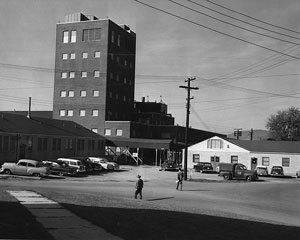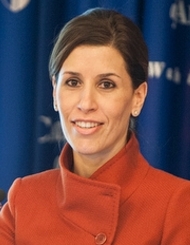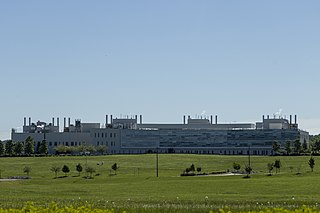Related Research Articles

Bioterrorism is terrorism involving the intentional release or dissemination of biological agents. These agents include bacteria, viruses, insects, fungi, and/or their toxins, and may be in a naturally occurring or a human-modified form, in much the same way as in biological warfare. Further, modern agribusiness is vulnerable to anti-agricultural attacks by terrorists, and such attacks can seriously damage economy as well as consumer confidence. The latter destructive activity is called agrobioterrorism and is a subtype of agro-terrorism.
Biodefense refers to measures to restore biosecurity to a group of organisms who are, or may be, subject to biological threats or infectious diseases. Biodefense is frequently discussed in the context of biowar or bioterrorism, and is generally considered a military or emergency response term.

Fort Detrick is a United States Army Futures Command installation located in Frederick, Maryland. Fort Detrick was the center of the U.S. biological weapons program from 1943 to 1969. Since the discontinuation of that program, it has hosted most elements of the United States biological defense program.

The United States Army Medical Research Institute of Infectious Diseases is the U.S Army's main institution and facility for defensive research into countermeasures against biological warfare. It is located on Fort Detrick, Maryland, near Washington, D.C., and is a subordinate lab of the United States Army Medical Research and Development Command (USAMRDC), headquartered on the same installation.

Operation Whitecoat was a biodefense medical research program carried out by the United States Army at Fort Detrick, Maryland between 1954 and 1973. The program pursued medical research using volunteer enlisted personnel who were eventually nicknamed "Whitecoats". These volunteers, all conscientious objectors, including many members of the Seventh-day Adventist Church, were informed of the purpose and goals of each project before providing consent to participate in any project. The stated purpose of the research was to defend troops and civilians against biological weapons.
William C. Patrick III was an influential microbiologist and bioweaponeer for the U.S. Army during the Cold War.
The National Biodefense Analysis and Countermeasures Center (NBACC) is a government biodefense research laboratory created by the U.S. Department of Homeland Security (DHS) and located at the sprawling biodefense campus at Fort Detrick in Frederick, MD, USA. The NBACC is the principal U.S. biodefense research institution engaged in laboratory-based threat assessment and bioforensics. NBACC is an important part of the National Interagency Biodefense Campus (NIBC) also located at Fort Detrick for the US Army, National Institutes of Health and the US Department of Agriculture.
The United States biological weapons program officially began in spring 1943 on orders from U.S. President Franklin D. Roosevelt. Research continued following World War II as the U.S. built up a large stockpile of biological agents and weapons. Over the course of its 27-year history, the program weaponized and stockpiled seven bio-agents — Bacillus anthracis (anthrax), Francisella tularensis (tularemia), Brucella spp (brucellosis), Coxiella burnetii (Q-fever), Venezuelan equine encephalitis virus, Botulinum toxin (botulism), and Staphylococcal enterotoxin B. The US also pursued basic research on many more bio-agents. Throughout its history, the U.S. bioweapons program was secret. It was later revealed that laboratory and field testing had been common. The official policy of the United States was first to deter the use of bio-weapons against U.S. forces and secondarily to retaliate if deterrence failed.

Building 470 — also called the Pilot Plant, or sometimes “the Tower”, or “Anthrax Tower” — was a seven-story steel and brick building at Fort Detrick in Frederick, Maryland, United States, used in the small-scale production of biological warfare (BW) agents. The building, a Cold War era structure, was transferred from the Department of Defense to the National Cancer Institute-Frederick in 1988, to which it belonged until 2003 when it was demolished.

Lester Martínez López is an American government official and former Army general who serves as the Assistant Secretary of Defense for Health Affairs since 2023. While in the United States Army, Martínez López was the first Hispanic to head the Army Medical and Research Command at Fort Detrick, Maryland. His responsibilities included overseeing the Army Medical Research Institute of Infectious Disease, which develops antidotes and vaccines for diseases soldiers might face on the battlefield.

The Administration for Strategic Preparedness and Response (ASPR) is an operating agency of the U.S. Public Health Service within the Department of Health and Human Services that focuses preventing, preparing for, and responding to the adverse health effects of public health emergencies and disasters. Its functions include preparedness planning and response; building federal emergency medical operational capabilities; countermeasures research, advance development, and procurement; and grants to strengthen the capabilities of hospitals and health care systems in public health emergencies and medical disasters. The office provides federal support, including medical professionals through ASPR’s National Disaster Medical System, to augment state and local capabilities during an emergency or disaster.
The United States Army Medical Unit (1956–1969) – a now defunct medical research unit for biodefense – was at Fort Detrick, Maryland, US. In contrast to the U.S. Army Biological Warfare Laboratories (1943–1969), also at Fort Detrick, the USAMU's mission was purely to develop defensive measures against bio-agents, as opposed to weapons development. The USAMU was the predecessor to today's USAMRIID.

Susan Lynn Brooks is an American prosecutor and politician. She is a Republican and the former U.S. Representative for Indiana's 5th congressional district. She was elected in 2012. The district includes the northern fifth of Indianapolis, as well as many of the city's affluent northern and eastern suburbs. Brooks served as the United States Attorney for the Southern District of Indiana from 2001 to 2007.
The United States Biological Defense Program—in recent years also called the National Biodefense Strategy—refers to the collective effort by all levels of government, along with private enterprise and other stakeholders, in the United States to carry out biodefense activities.

Luciana Borio is a Brazilian-American infectious disease physician and public health administrator. She is a vice president at In-Q-Tel. She previously served as director for Medical and Biodefense Preparedness at the National Security Council, acting chief scientist of the U.S. Food and Drug Administration (FDA), assistant commissioner for counterterrorism policy of the FDA, and director of FDA's Office of Counterterrorism and Emerging Threats. She is known for her work advancing clinical trials, the development of medical countermeasures for health emergencies, and the public health responses to Ebola and Zika outbreaks.
The Bipartisan Commission on Biodefense, formerly known as the Blue Ribbon Study Panel on Biodefense, is an organization of former high-ranking government officials that analyzes US capabilities and capacity to defend against biological threats. According to the Commission's mission statement, the organization was formed to "provide for a comprehensive assessment of the state of U.S. biodefense efforts, and to issue recommendations that will foster change."

The Frederick National Laboratory for Cancer Research (FNLCR) is one of the 18 United States National Laboratories and the only U.S. National Laboratory exclusively dedicated to biomedical research. The Frederick National Laboratory is sponsored by NIH/National Cancer Institute (NCI) as a Federally Funded Research and Development Centers, and its day-to-day operation is managed by the private contractor Leidos Biomedical Research for the NCI. The institution was originally established under the name NCI-Frederick Cancer Research Center in 1972 as a component of U.S. President Richard Nixon's War on Cancer initiative. In 2012, the institution received a National Laboratory designation and assumed its current name, becoming the only U.S. national laboratory dedicated entirely to biomedical research. The campus located within Fort Detrick U.S. Army Installation in Frederick, Maryland, also houses National Cancer Institute laboratories and administrative organizations, and is colloquially referred to as NCI-Frederick.

The Alliance for Biosecurity is a consortium of companies that develop products to respond to national security threats, including bioterrorism pathogens and emerging infectious diseases. It is headquartered in Washington DC.
The National Interagency Biodefense Campus is a facility in Frederick, MD at Fort Detrick. It hosts members of a scientific collaboration, the National Interagency Confederation for Biological Research.

John Ring La Montagne was a Mexican-American biomedical scientist who served as the deputy director of the National Institute of Allergy and Infectious Diseases from 1998 to 2004. He specialized in viral vaccines, HIV/AIDS research, and oversaw NIH's biodefense research after the September 11 attacks.
References
- ↑ Public Affairs and Community Relations Subcommittee, Fort Detrick Standard [Special to the Standard: Thursday, Jan 5, 2012]
- 1 2 3 Gilman JK, Wright M, Lane HC, Schoomaker EB (1 May 2014). "A Model of Federal Interagency Cooperation: The National Interagency Confederation for Biological Research". Biosecurity and Bioterrorism. Mary Ann Liebert. 12 (3): 144–150. doi:10.1089/bsp.2013.0084. eISSN 1557-850X. ISSN 1538-7135. PMC 4043433 . PMID 24819736.
- ↑ "National Interagency Confederation for Biological Research (NICBR)". 22 June 2023. Retrieved 7 January 2024.
![]() This article incorporates text from this source, which is in the public domain : https://web.archive.org/web/20170114202529/https://www.detrick.army.mil/standard/entry.cfm?entry_id=ABA5D9E5-AEC8-4369-7E9CD208A1067C96
This article incorporates text from this source, which is in the public domain : https://web.archive.org/web/20170114202529/https://www.detrick.army.mil/standard/entry.cfm?entry_id=ABA5D9E5-AEC8-4369-7E9CD208A1067C96